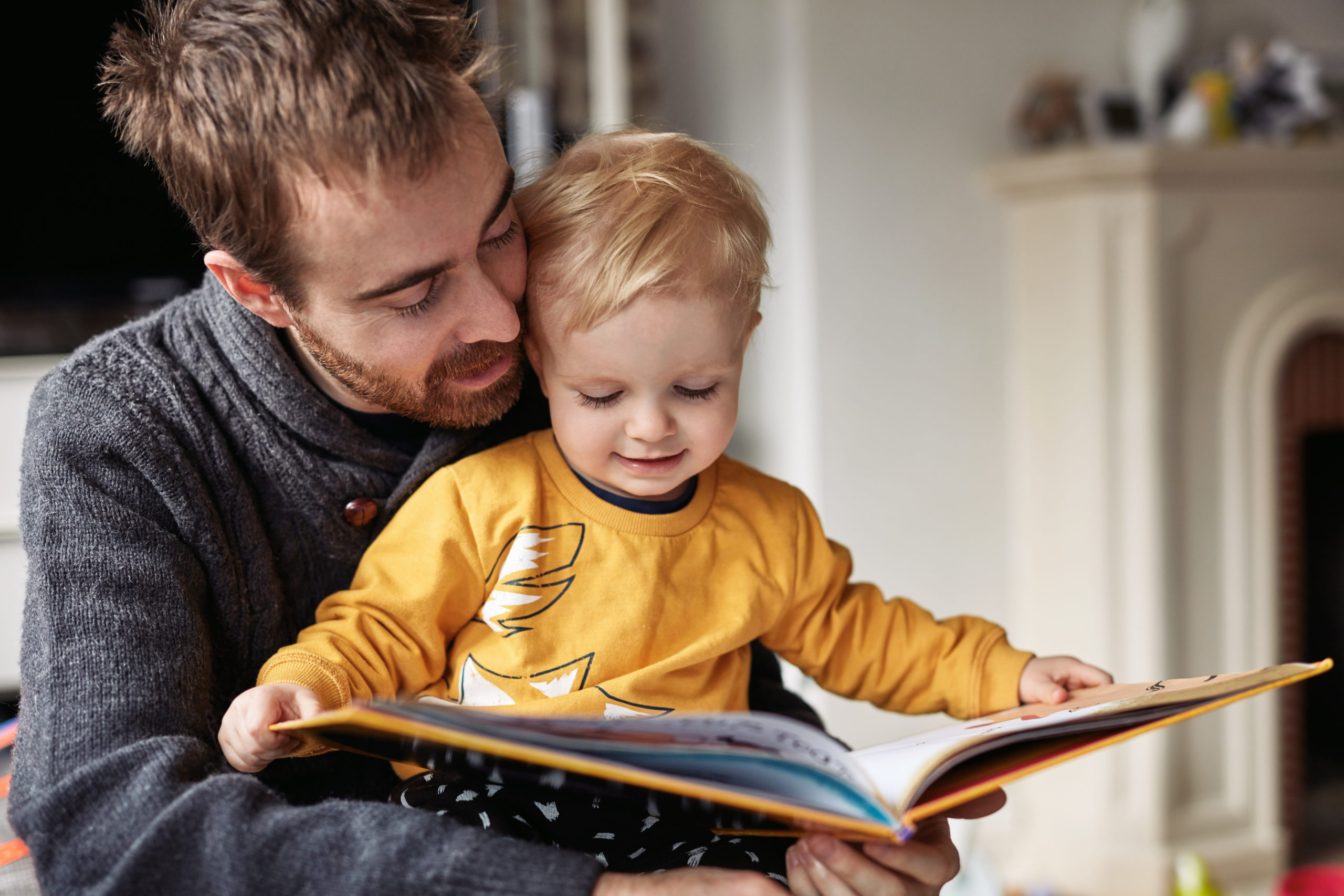Is My Child Ready to Start Talking: Importance of Prelinguistic Language

Did you know, as soon as babies are born, they start to develop communication skills? Before toddlers start talking, babies learn prelinguistic (before language) skills. These skills will help to support language learning later in life. Prelinguistic communication is the way babies communicate without using words. Even as adults, we continue to use prelinguistic skills to communicate. Prelinguistic communication includes: gestures, eye contact, facial expressions, non-word vocalizations, imitation, and joint attention. Development of these skills set children up to be successful verbal communicators.
Why is Prelinguistic Language Important?
Prelinguistic skills form the foundation for which talking and understanding language is developed. A baby who has difficulty looking at their mother and attending to her while she is talking has fewer opportunities to see how words and sounds are made. They also have fewer opportunities to attach meaning to those words. Compare this to a child who enjoys watching their mother’s face. The child who is watching and attending is learning how the mouth moves to make sounds and words. This child is better able to attach meaning to what they are hearing and seeing.
In addition, infants and toddlers with joint attention difficulties (when you and your child are looking at or attending to the same thing at the same time) will have less opportunities to learn about things in their environment. When a child looks at something with an adult, and the adult comments on that thing, it provides a chance for the child to attach meaning to a word and learn more about the world. If the child cannot attend to things with adults, they lose out on these learning opportunities.
One common example would be if you are outside and hear an airplane. You and your child look up to the sky at the airplane, and you point and say, “airplane.” If your child has joint attention difficulties, they may not be able to follow your gaze or point up to the sky. So, when you say, “airplane,” they are looking at something different and are unable to attach meaning to that word.
Infants who have difficulty developing prelinguistic skills will likely face challenges developing verbal language skills and may also have difficulty interacting with others. Working on developing prelinguistic skills early on may lead to less difficulties communicating as your child moves from infancy to toddlerhood and beyond.
Skills Necessary to Develop Prelinguistic Communication
Looking and Listening
Babies look to their mother’s face as soon as they are born. They learn to discriminate human faces and recognize which faces are important. The ability to attend visually will allow babies to gain information about language by watching faces and mouths. Similar things occur with listening. Babies start to recognize human voices and learn which ones are important.
Turn Taking
Turn taking begins to develop within the first weeks after your baby is born. Parents begin responding to their baby’s smiles, vocalizations, and movements by adding sounds, actions, and words. Eventually, parents begin to leave gaps in their responses to allow their baby to respond. This develops into a back-and-forth interaction. You make a funny noise, your baby smiles, you make the noise again, your baby laughs and vocalizes.
Smiling
Babies begin smiling around six weeks of age. When babies smile, it fosters increased interactions between babies and their caregivers. Adults are more likely to continue interacting with babies when they are rewarded with a response like a smile. When babies are responsive to adult interactions, adults initiate communication more often.
Anticipation and Prelinguistic Language
By three months of age, babies should start to show excitement when they hear sounds associated with familiar situations. For example, your baby becomes excited when she hears the bathwater running because she knows it is almost bath time. During this time, awareness of gestures and facial expressions also expands. Babies show increased understanding that facial expressions and gestures carry meaning, and babies begin anticipating what will happen next based on a specific gesture or facial expression.
Copying
Imitating others fosters social interactions. By the time babies are nine months old, they should be able to copy simple gestures (hand clapping) and playful mouth movements (blowing raspberries, smacking lips, etc.). Children are more likely to be successful imitating words and phrases, if they are able to copy movements and gestures as an infant.
Joint Attention
Joint attention is when your baby is able to follow your focus of attention so you are both attending to the same thing at the same time. Babies should attend jointly to things with their parents and other adults. Joint attention also includes a baby’s ability to direct someone else’s attention to what they are interested in. By 12 months of age, toddlers should be able to point to what they are interested in. This encourages adults to engage even more, by naming the objects the toddler is pointing to. Non verbal communication skills continue to develop even as children begin to develop verbal language skills. Non verbal language remains strongly linked to verbal communication throughout language development.
Prelinguistic Language and Understanding
In a child’s first 12 months of life, understanding is based on non-language cues they pick up in the environment. This includes pointing, gestures, direction of eye gaze, and facial expressions. By 12 months of age, children should develop understanding of words such as “no” and “bye.” Many children have difficulty understanding because adults speak too quickly. This makes it difficult for children to pick out the important words in time. As children get older, this becomes easier.
Expression
Infants and toddlers need to be able to effectively communicate before they are able to start using first words. This occurs through nonverbal communication and includes use of gestures, facial expressions, vocalizations, and body language. First words appear between 10 to 15 months of age.

Is Your Child Having Difficulty with Prelinguistic Skills?
If your child is having difficulty developing prelinguistic skills you may notice these things:
- Your child does not make eye contact or eye contact is limited
- Does not use different sounds and vocalizations to indicate feelings (happy, sad, tired, etc.)
- Child does not respond with a social smile
- Not producing playful vocalizations or babbling as a baby
- Limited or no use of gestures or voice to gain attention from others
- Difficulty or not attempting to copy facial expressions or gestures
- Child does not enjoy others playing with them or alongside them
- Does not attempt to show you things or draw your attention to things they find interesting
- Your child does not respond to different gestures or tones of voice (happy face/voice versus angry face/voice)
How to Improve Prelinguistic Language
- Take some time each day to play with your baby or child. This could include peek-a-boo or songs and finger plays for babies and dress up and hide and seek for toddlers and children. Reading books together is also great at any age.
- Participate in joint attention. Follow your child’s gaze and talk about what they are looking at or interested in using simple language.
- Talk to your baby or child throughout the day. Explain what you are doing so your child begins to link words with actions.
- Simplify your language. Use shorter sentences and age-appropriate vocabulary. Also, slow down when you are talking to give your child more time to comprehend what you are saying.
- Get on your child’s level. When you are face to face with your child when speaking, they can watch how your mouth moves and learn how to form sounds. They will also learn more about facial expressions.
- Eliminate background noise. Turn off the TV or radio, so your baby or child can start to distinguish voices better.
- Vary your intonation and voice. Changing your intonation will help to gain your child’s attention.
For more ideas on activities to do with your toddler to encourage both prelinguistic and verbal language, you can check out another one of MOSAIC’s blogs Birth to Five Language for Real Life. Parents Magazine also has some great activities you can easily do at home with your infant. If you have any questions regarding your infant or toddler’s language development reach out to one our skilled speech therapists at Mosaic Health & Rehab (406) 388-4988.
